Bài giảng Macroeconomics - Chapter 1: Introduction to economics - Nguyễn Thùy Dung
In this section,
look for answers for these questions:
What kinds of questions does economics
address?
What are the principles of how people make
decisions and interact with another?
What are forces and trends that affect the
economy as a whole?
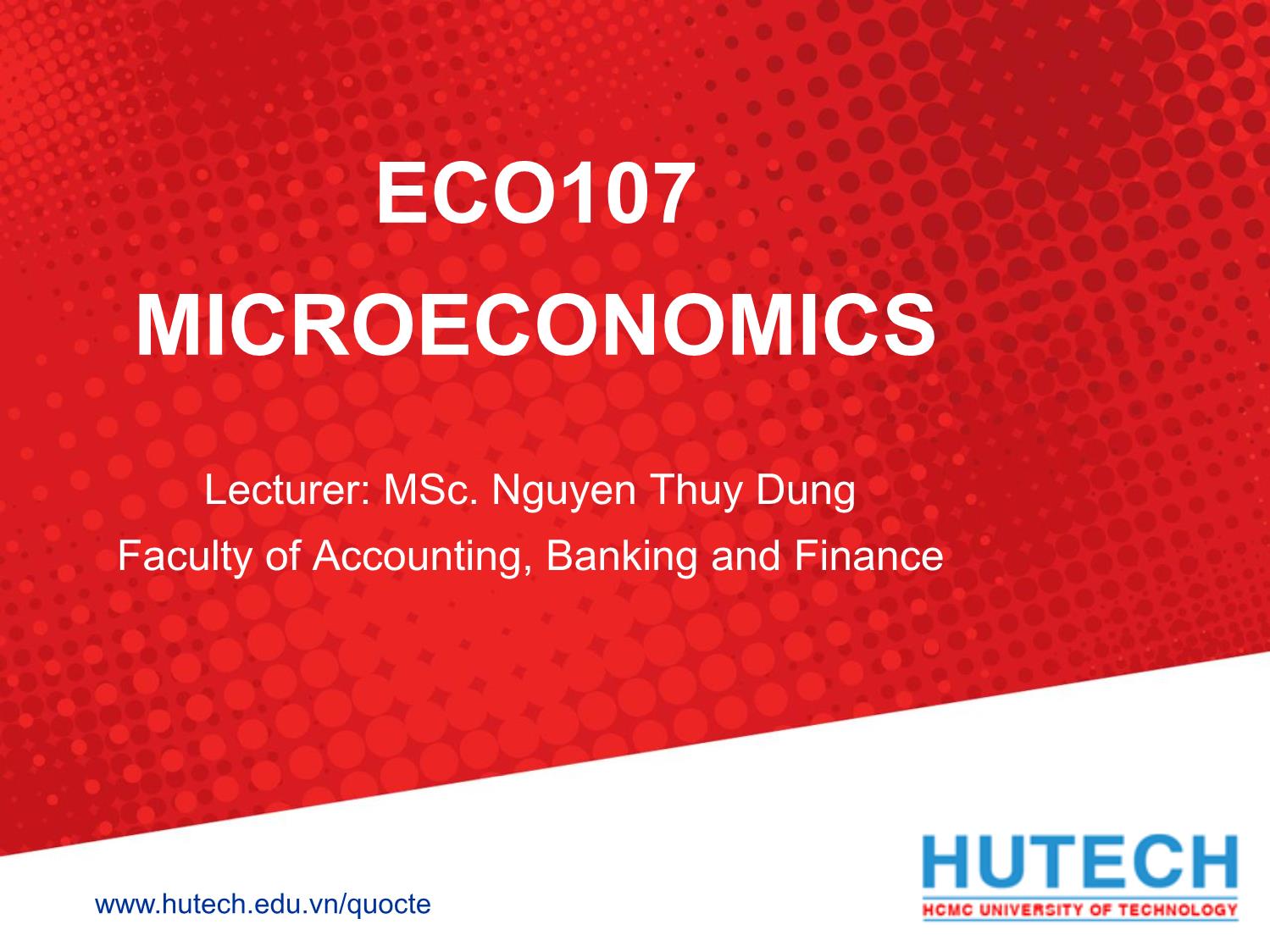
Trang 1
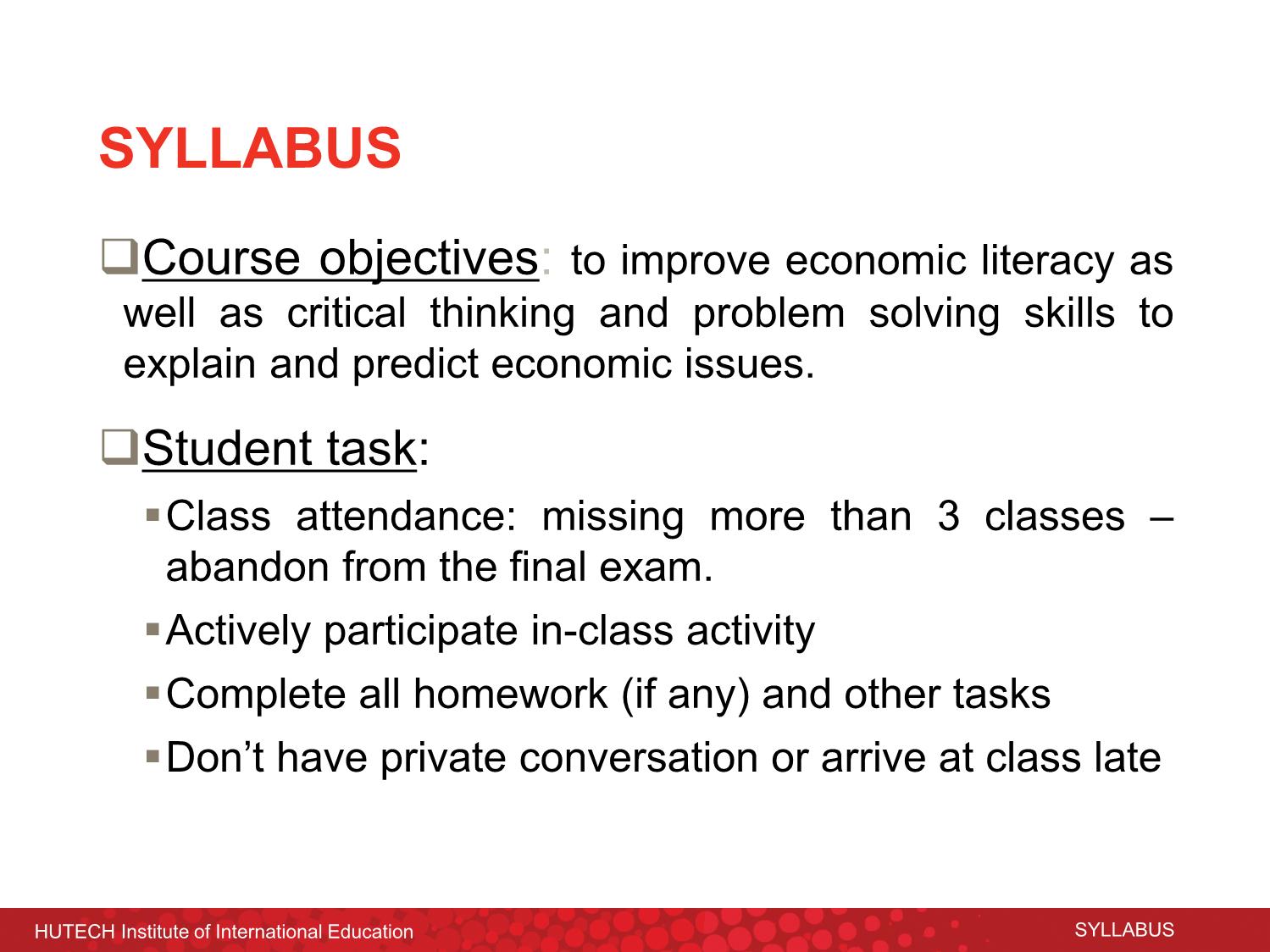
Trang 2
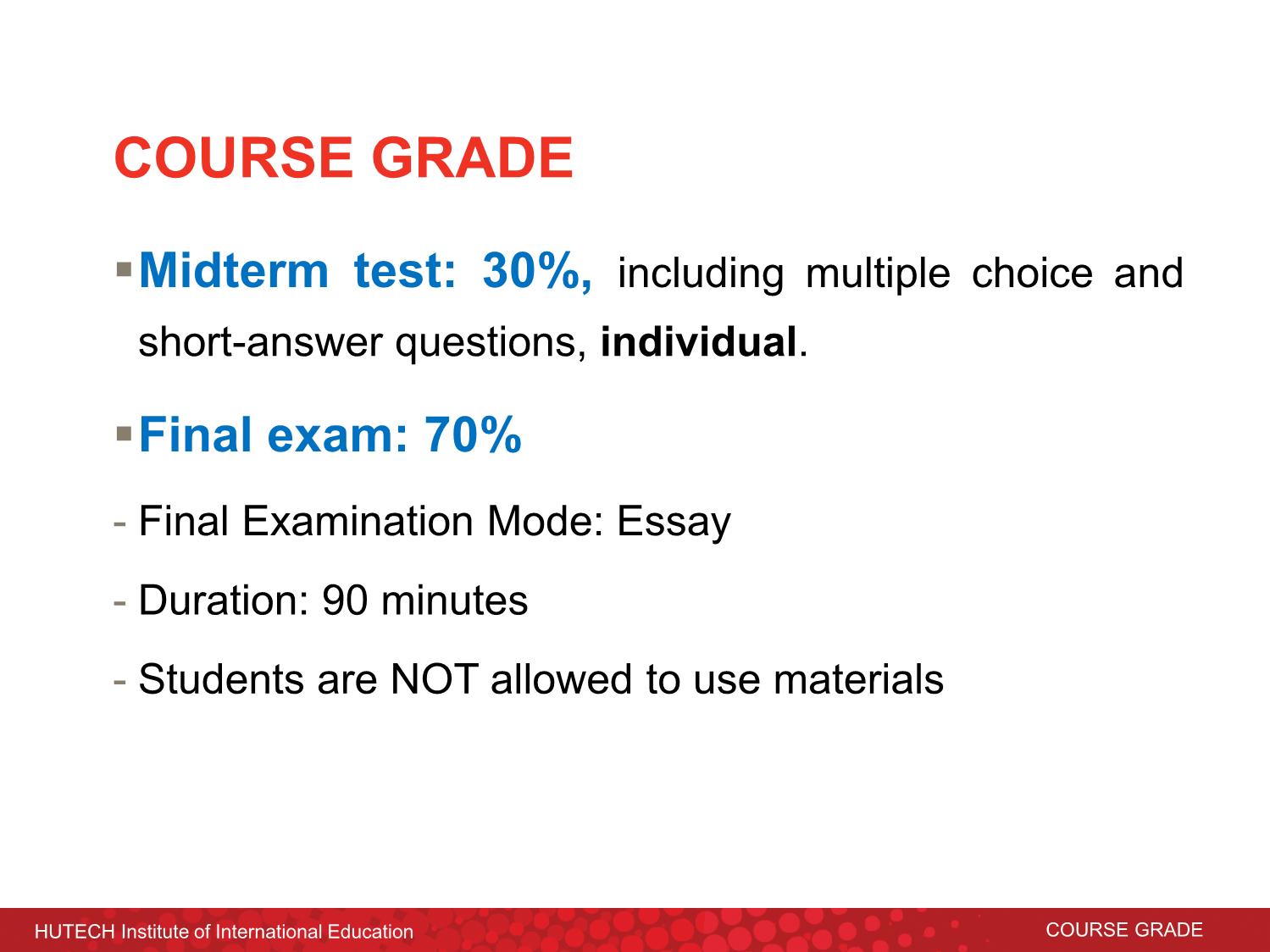
Trang 3
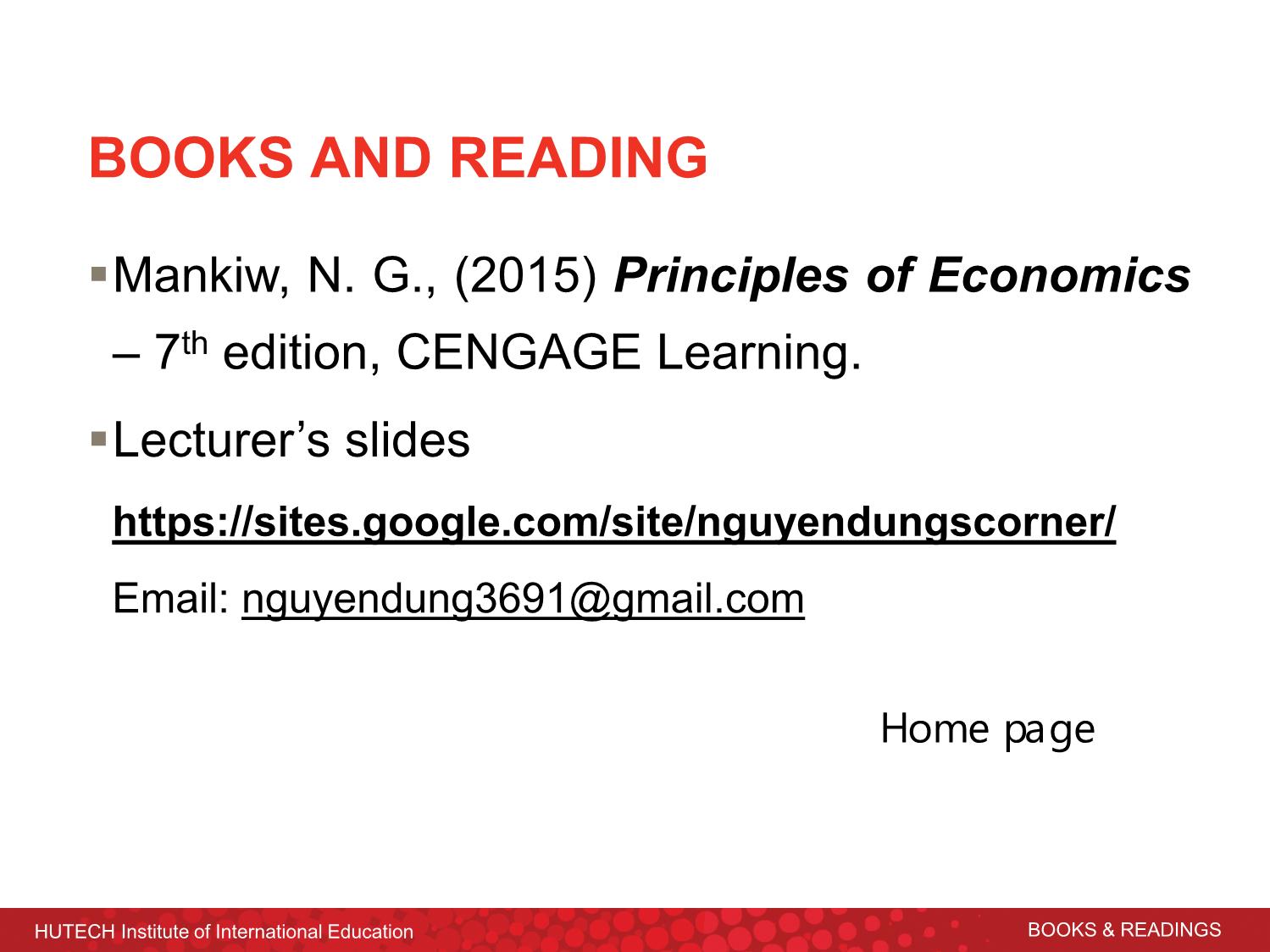
Trang 4
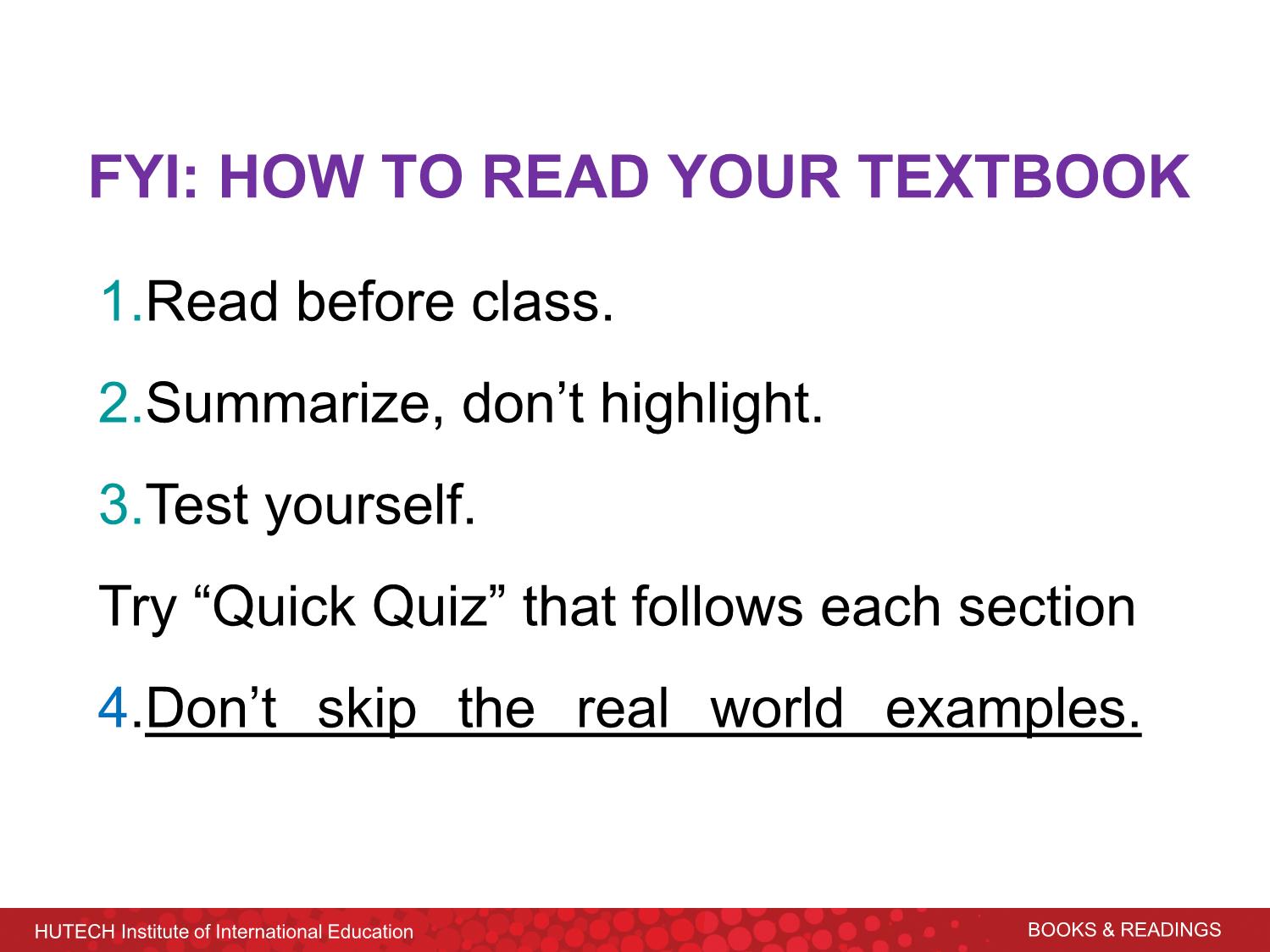
Trang 5
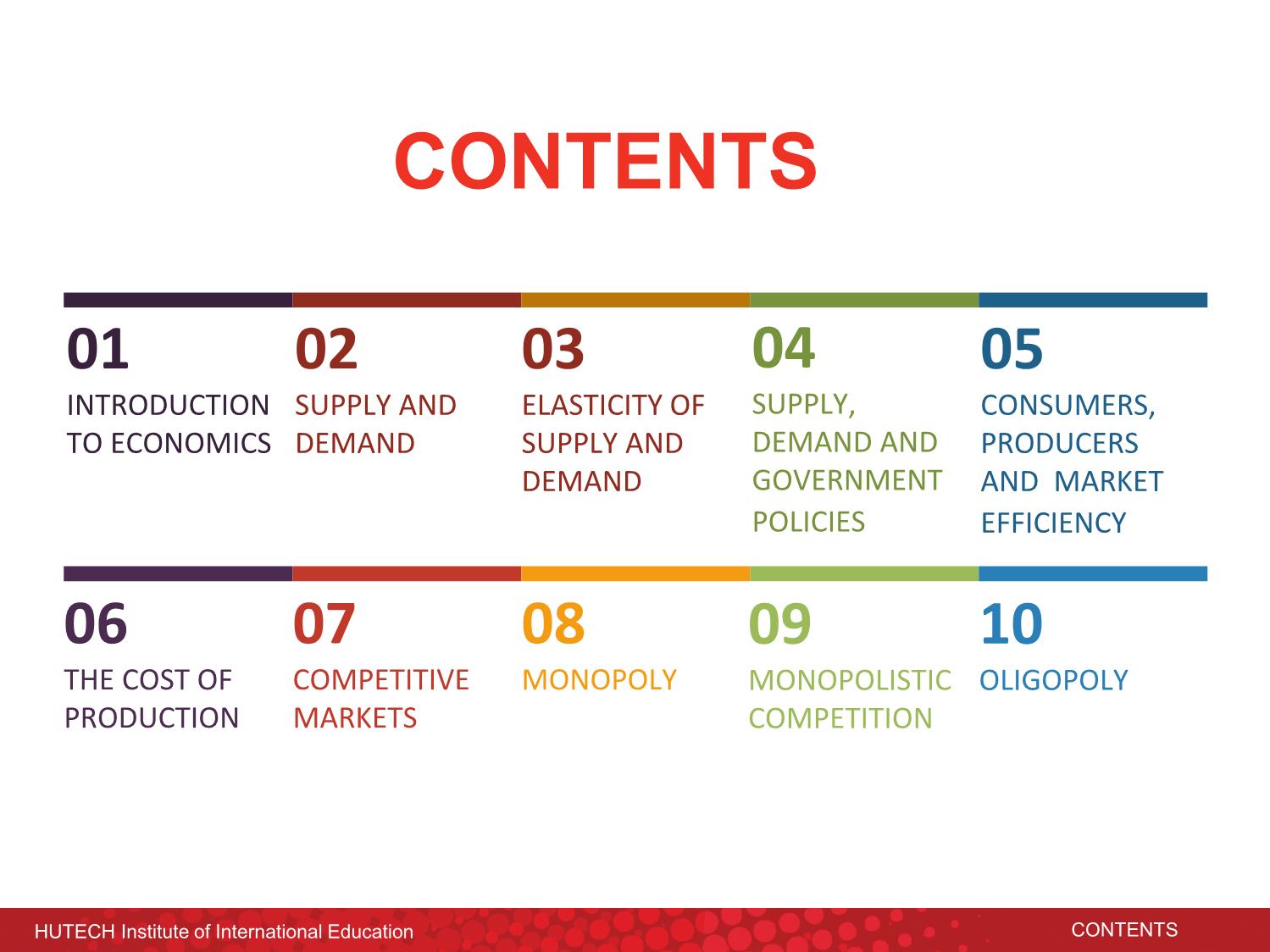
Trang 6
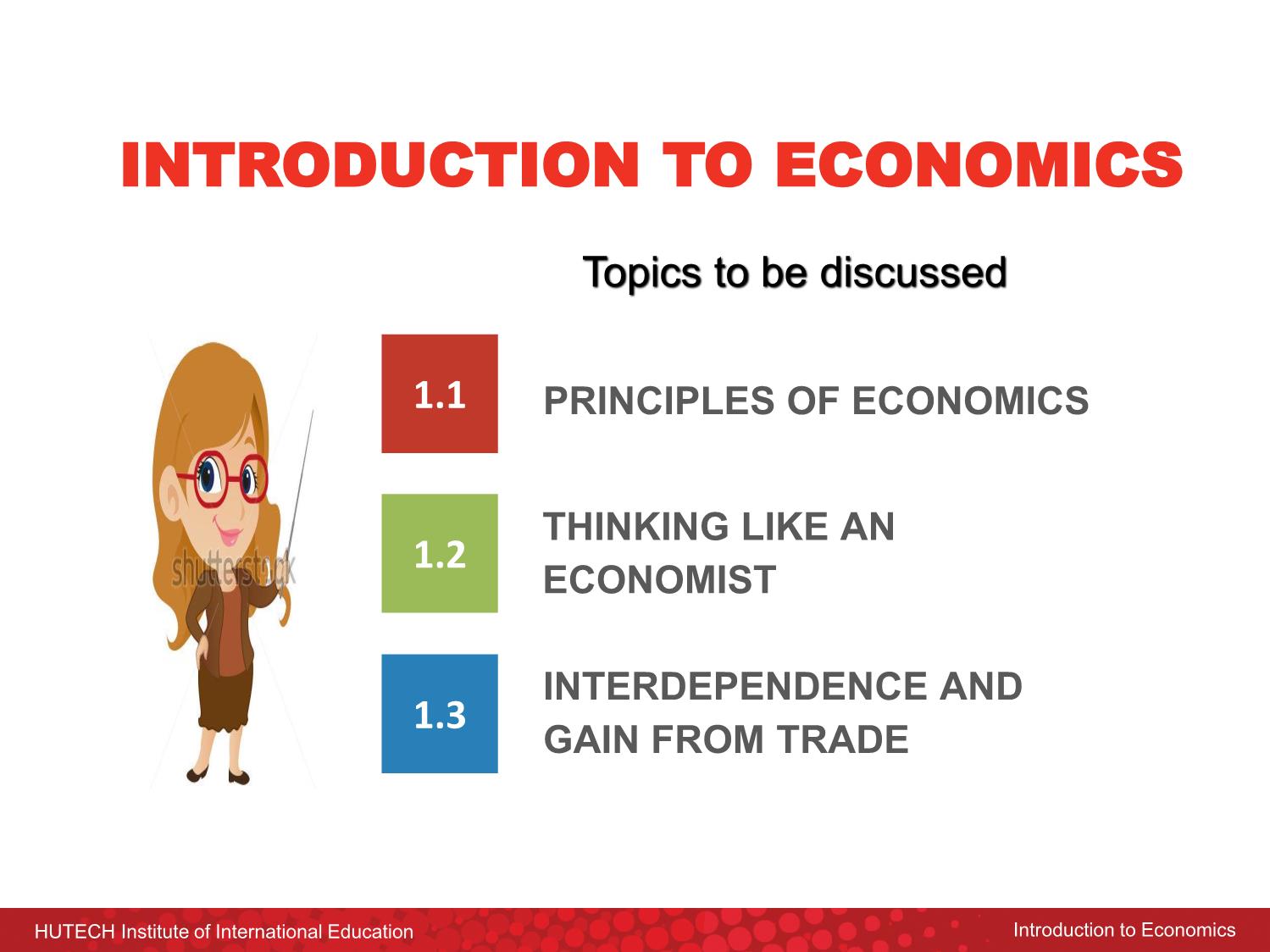
Trang 7
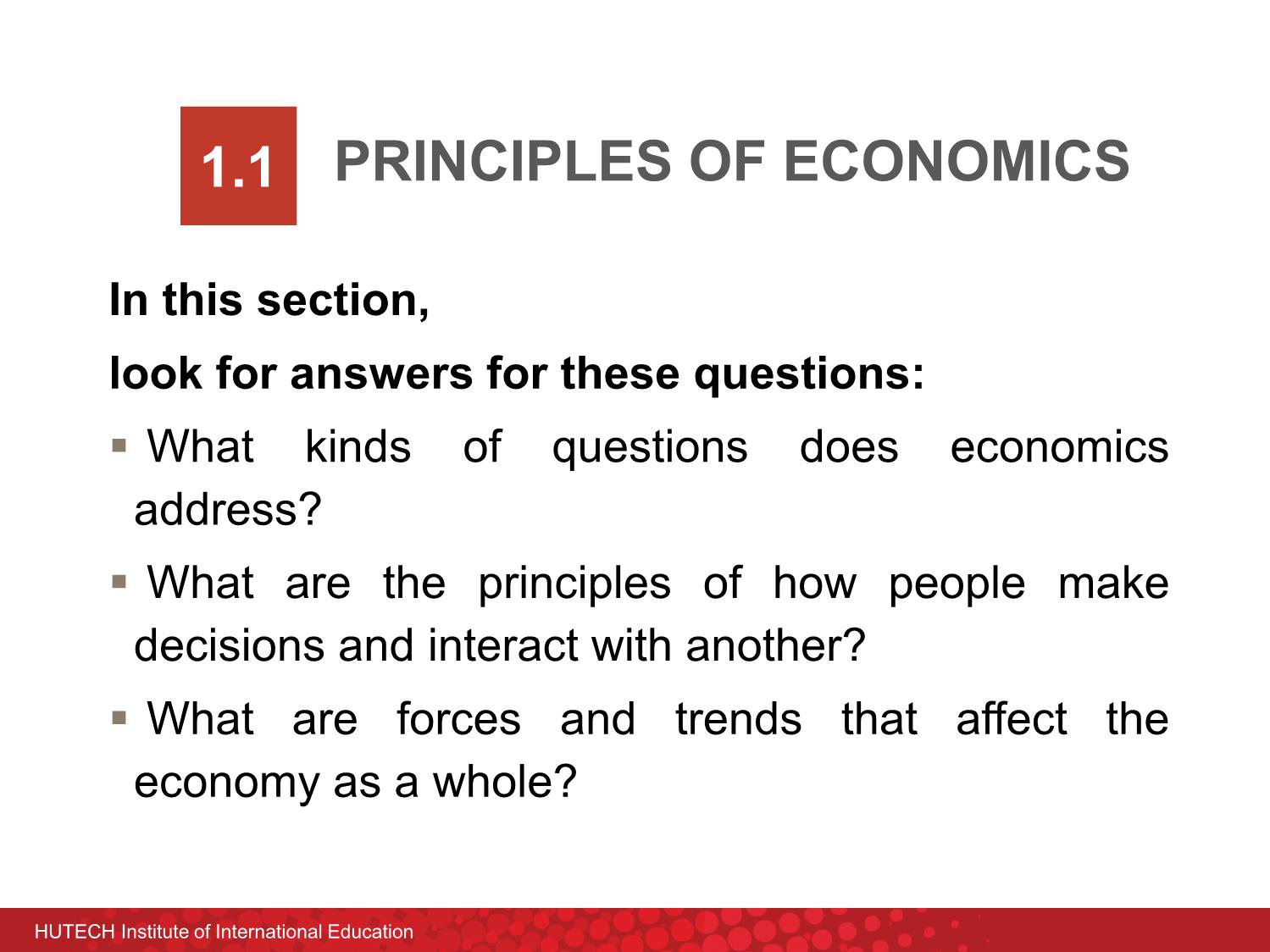
Trang 8

Trang 9
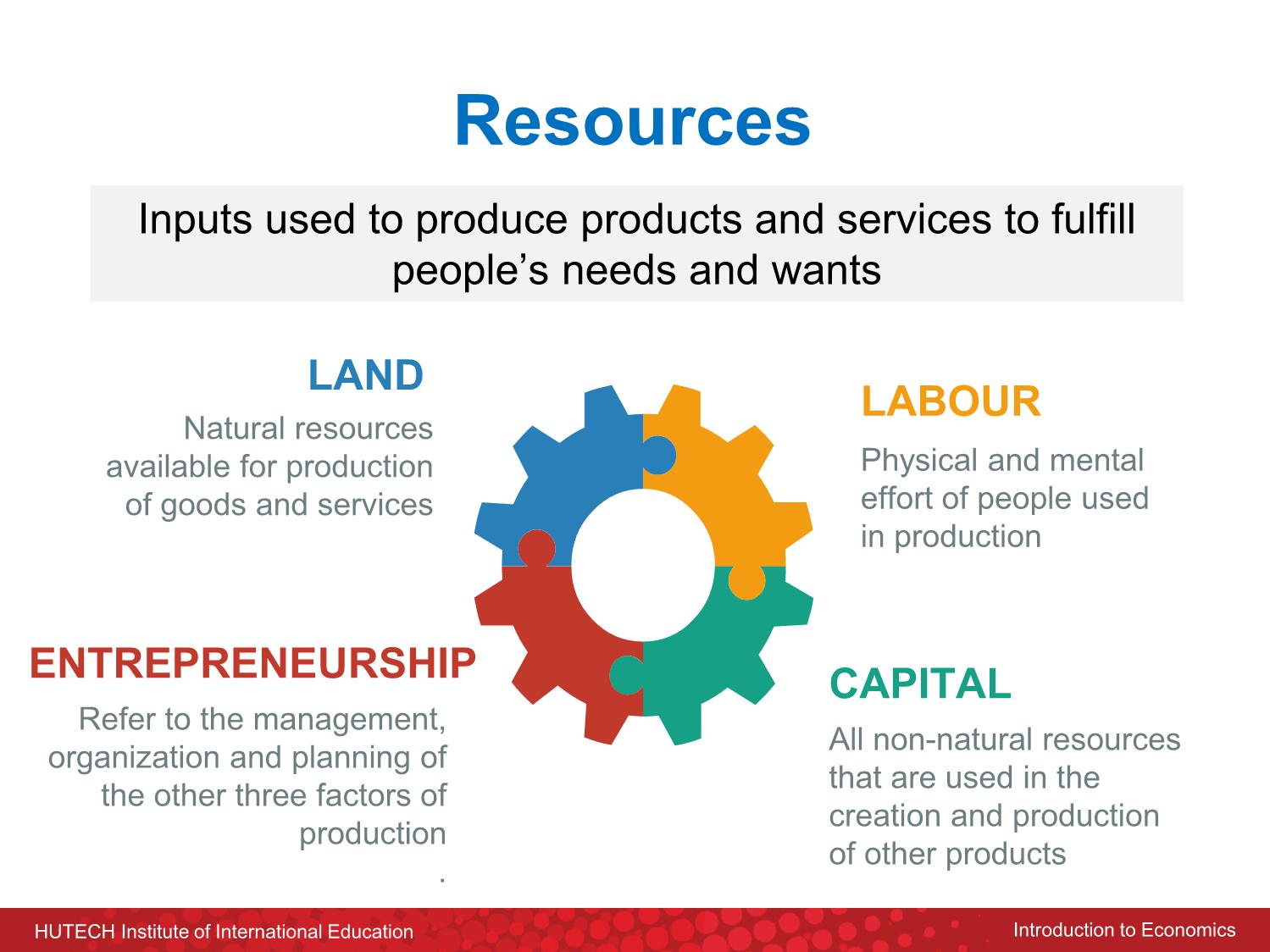
Trang 10
Tải về để xem bản đầy đủ
Bạn đang xem 10 trang mẫu của tài liệu "Bài giảng Macroeconomics - Chapter 1: Introduction to economics - Nguyễn Thùy Dung", để tải tài liệu gốc về máy hãy click vào nút Download ở trên
Tóm tắt nội dung tài liệu: Bài giảng Macroeconomics - Chapter 1: Introduction to economics - Nguyễn Thùy Dung
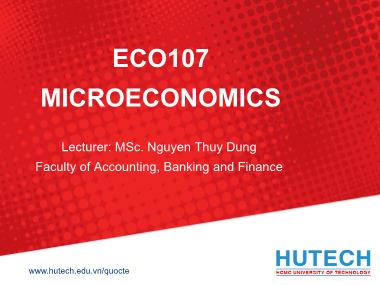
limited human wants in a world of limited resources Scarcity The Economic Problem? •Unlimited Wants •Scarce Resources – Land, Labour, Capital, Entrepreneurship •Choices - What we want (need) versus what we can give up (live without) HUTECH Institute of International Education Introduction to Economics What Economics Is All About? • Economics is the study of the choices people and societies make to obtain their unlimited wants, given their scarce resources. • In this subject we study how people make choices and interact in markets. HUTECH Institute of International Education Introduction to Economics Economics is the study of how society manages its scarce resources. What Economics Is All About? 3 basic economic problems HUTECH Institute of International Education Introduction to Economics 10 Principles of Economics HOW PEOPLE MAKE DECISIONS People face tradeoffs Opportunity cost Rational people think at a margin People respond to incentives HOW PEOPLE INTERACT Trade Can Make Everyone Better Off Market Organizes Economic Activity Governments Can Improve Market Outcomes HUTECH Institute of International Education Introduction to Economics 10 Principles of Economics HOW THE ECONOMY AS A WHOLE WORKS A Country‟s Standard of Living Depends on Its Ability to Produce Goods & Services Prices Rise When the Government Prints Too Much Money Society Faces a Short-run Tradeoff Between Inflation and Unemployment HUTECH Institute of International Education Introduction to Economics 4 principles of HOW PEOPLE MAKE DECISIONS HUTECH Institute of International Education Introduction to Economics HOW PEOPLE MAKE DECISION • Choice involves sacrifice, meaning choosing one thing means leaving the other things. → All decisions involve tradeoffs • Opportunity cost refers to the cost of an activity measured in terms of the best alternative forgone Principle #1: People Face Tradeoffs HUTECH Institute of International Education Introduction to Economics HOW PEOPLE MAKE DECISION • Important tradeoff: “efficiency” vs “equality” Efficiency: means that society is getting the maximum benefits from its scarce resources Equality: means that those benefits are distributed uniformly among society‟s members → Tradeoff: To achieve greater equality, could redistribute income from wealthy to poor. But this reduces incentive to work Principle #1: People Face Tradeoffs HUTECH Institute of International Education Introduction to Economics HOW PEOPLE MAKE DECISION Acknowledging life’s trade-offs is important because people are likely to make good decisions only if they understand the options that are available to them Principle #1: People Face Tradeoffs HUTECH Institute of International Education Introduction to Economics HOW PEOPLE MAKE DECISION • Making decisions requires comparing the costs and benefits of alternative choices. • The opportunity cost of any item is whatever must be given up to obtain it. • The cost of an action is not as obvious as it might first appear. Principle #2: The Cost of Something Is What You Give Up to Get It HUTECH Institute of International Education Introduction to Economics HOW PEOPLE MAKE DECISION • Examples: The opportunity cost of going to college for a year is not just the tuition, books, and fees, but also the foregone wages. seeing a movie is not just the price of the ticket, but the value of the time you spend in the theater. Principle #2: The Cost of Something Is What You Give Up to Get It HUTECH Institute of International Education Introduction to Economics HOW PEOPLE MAKE DECISION Rational people • who systematically and purposefully do the best they can to achieve their objectives. • Term “marginal changes” – a small incremental adjustments to an existing plan of action. • Rational people make decisions by comparing marginal benefits and marginal costs. Principle #3: Rational People Think at the Margin HUTECH Institute of International Education Introduction to Economics HOW PEOPLE MAKE DECISION Examples: • Considers whether to go to college for an additional year, you need to compares the fees & foregone wages to the extra income he could earn with the extra year of education. A rational decision maker takes an action if and only if the marginal benefit of the action exceeds the marginal cost. Principle #3: Rational People Think at the Margin HUTECH Institute of International Education Introduction to Economics HOW PEOPLE MAKE DECISION Incentive: something that induces a person to act, i.e. the prospect of a reward or punishment. A higher price in a market provides an incentive for buyers to consume less and an incentive for sellers to produce more. Public policy: change costs or benefits, and as a result, change people‟s behavior. Principle #4: People respond to Incentives HUTECH Institute of International Education Introduction to Economics 3 principles of HOW PEOPLE INTERACT HUTECH Institute of International Education Introduction to Economics HOW PEOPLE INTERACT Trade allows each person to specialize in the activities he or she does best Countries also benefit from trade & specialization: • Get a better price abroad for goods they produce • Buy other goods cheaper from abroad than goods could be produced at home Principle #5: Trade Can Make Everyone Better Off HUTECH Institute of International Education Introduction to Economics HOW PEOPLE INTERACT Communist countries – central planners make all decisions, i.e. what, how and who goods and services were produced Market economy - an economy that allocates resources through the decentralized decisions of many firms and households as they interact in markets for goods and services Principle #6: Markets Are Usually a Good Way to Organize Economic Activity HUTECH Institute of International Education Introduction to Economics HOW PEOPLE INTERACT Famous insight by Adam Smith in The Wealth of Nation (1776): Households and firms act as if they are guided by an invisible hand” that leads them to desirable market outcomes. The invisible hand works through the price system Principle #6: Markets Are Usually a Good Way to Organize Economic Activity HUTECH Institute of International Education Introduction to Economics HOW PEOPLE INTERACT We need government: Enforce rules and maintain institutions • Enforce property rights Promote efficiency • Avoid market failure Promote equality • Avoid disparities in economic well-being Principle #7: Governments Can Sometimes Improve Market Outcomes HUTECH Institute of International Education Introduction to Economics 3 principles of HOW THE ECONOMY AS A WHOLE WORKS HUTECH Institute of International Education Introduction to Economics HOW THE ECONOMY AS A WHOLE WORKS Huge variation in living standards across countries and over time Explanation: differences in productivity - the amount of goods and services produced per unit of labor input Productivity depends on the equipment, skills, and technology available to workers. Principle #8: A country’s standard of living depends on its ability to produce goods & services. HUTECH Institute of International Education Introduction to Economics HOW THE ECONOMY AS A WHOLE WORKS Inflation: a situation of rapidly increasing in the general level of prices Principle #9: Prices Rise When the Government Prints Too Much Money Excessive growth in the quantity of money causes the value of money to fall. HUTECH Institute of International Education Introduction to Economics HOW THE ECONOMY AS A WHOLE WORKS In the short-run (1 – 2 years), many economic policies push inflation and unemployment in opposite directions. Other factors can make this tradeoff more or less favorable, but the tradeoff is always present. Principle #10: Society Faces a Short-Run Trade-off between Inflation and Unemployment HUTECH Institute of International Education Introduction to Economics Ten Principles of Economics HUTECH Institute of International Education In this section, look for answers for these questions: What are economists‟ two roles? What are models? How do economists use them? What are the elements of the Circular-Flow Diagram? What concepts does the diagram illustrate? How is the Production Possibilities Frontier related to opportunity cost THINKING LIKE AN ECONOMIST 1.2 Thinking like an Economist HUTECH Institute of International Education Thinking like an Economist Economist as Scientist – try to explain the world Economist as Policy advisor – try to improve it Thinking like an Economist HUTECH Institute of International Education Economist as Scientist Economists employ the scientific method • Devise theories • Collect data • Analyze data Verify or refute theories Make use of scientific method - observation, theory, and more observation The interplay between theory and observation always occurs in economics Thinking like an Economist HUTECH Institute of International Education Assumptions and Models Economic model: a highly simplified representation of a more complicated reality. Assumption: Judgments about features that can be ignored to make the world easier to understand. Ceteris paribus assumption: All other things being equal. The term refers to holding all other variables constant when one variable is changed. Thinking like an Economist HUTECH Institute of International Education Our first model The Circular-Flow Diagram Thinking like an Economist • The Circular-Flow Diagram: a visual model of the economy, shows how dollars flow through markets among households and firms • Two types of “decision makers”: – Firms: produce goods and services using factors of production – Households: consume all the goods and services • Two markets: – The market for goods and services – The market for “factors of production” HUTECH Institute of International Education The Circular-Flow Diagram Thinking like an Economist Households: Own the factors of production, sell/rent them to firms for income Buy and consume goods & services Households Firms Firms: Buy/hire factors of production, use them to produce goods and services Sell goods & services HUTECH Institute of International Education Thinking like an Economist FIGURE 1: The Circular-Flow Diagram Markets for Factors of Production Households Firms Income Wages, rent, profit Factors of production Labor, land, capital Spending Goods & Services sold Revenue Markets for Goods & Services Goods & Services bought HUTECH Institute of International Education Our second model The Production Possibilities Frontier Thinking like an Economist • The Circular-Flow Diagram: a visual model of the economy, shows how dollars flow through markets among households and firms • Two types of “decision makers”: – Firms: produce goods and services using factors of production – Households: consume all the goods and services • Two markets: – The market for goods and services – The market for “factors of production” HUTECH Institute of International Education • The PPF is a curve that show the possible combinations of two goods that can be produced with available technology and resources per unit of time • In production, opportunity cost is the quantity of one product need to sacrifice to product one unit of other product The Production Possibilities Frontier Thinking like an Economist HUTECH Institute of International Education (unit) Y X (unit) If economy„s output is at C, to increase 10 units of X, output of Y will have to decrease 30 units (at D) (not 10 units) M N The Production Possibilities Frontier Thinking like an Economist HUTECH Institute of International Education Example: • Two goods: computers and wheat and one resource: labor (measured in hours) • Economy has 50,000 labor hours per month available for production. - Produce 1 computer requires 100 hours labor - Produce 1 ton of wheat requires 10 hours labor. The Production Possibilities Frontier Thinking like an Economist HUTECH Institute of International Education The Production Possibilities Frontier Thinking like an Economist Employment of labor hours Production Computers Wheat Computers Wheat A 50,000 0 500 0 B 40,000 C 25,000 D 10,000 E 0 HUTECH Institute of International Education The Production Possibilities Frontier Thinking like an Economist Employment of labor hours Production Computers Wheat Computers Wheat A 50,000 0 500 0 B 40,000 10,000 400 1,000 C 25,000 25,000 250 2,500 D 10,000 40,000 100 4,000 E 0 50,000 0 5,000 HUTECH Institute of International Education The Production Possibilities Frontier Thinking like an Economist Point on graph Production Com- puters Wheat A 500 0 B 400 1,000 C 250 2,500 D 100 4,000 E 0 5,000 0 1,000 2,000 3,000 4,000 5,000 6,000 0 100 200 300 400 500 600 Computers Wheat (tons) A B C D E G F HUTECH Institute of International Education Thinking like an Economist Points on the PPF (like A – E) possible efficient: all resources are fully utilized Points under the PPF (like F) possible not efficient: some resources underutilized (e.g., workers unemployed, factories idle) Points above the PPF (like G) not possible The PFF: what we know so far HUTECH Institute of International Education Introduction to Economics Micro- and Macroeconomics • Macroeconomics deals with this problem at the aggregate (total) level. It focuses on the economy as a whole – ie. the “big picture” • Microeconomics deals with the problem at the level of individual units within the economy such as consumers and firms. HUTECH Institute of International Education Economist as Policy advisor As scientists, economists make positive statements, which attempt to describe the world as it is. As policy advisors, economists make normative statements, which attempt to prescribe how the world should be. Positive statements can be confirmed or refuted, normative statements cannot. Government employs many economists for policy advice. Thinking like an Economist HUTECH Institute of International Education QUICK CHECK A point inside the production possibilities frontier is efficient, but not feasible. feasible, but not efficient. both efficient and feasible. neither efficient nor feasible.
File đính kèm:
 bai_giang_macroeconomics_chapter_1_introduction_to_economics.pdf
bai_giang_macroeconomics_chapter_1_introduction_to_economics.pdf

